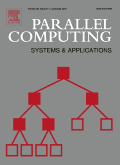
PARALLEL COMPUTING
Scope & Guideline
Empowering Research in Distributed Computing.
Introduction
Aims and Scopes
- Parallel Algorithms and Optimization Techniques:
Research on novel algorithms designed for efficient execution on parallel architectures, including improvements in computational speed and resource utilization. - High-Performance Computing Architectures:
Studies focusing on the design and implementation of hardware architectures that support parallel processing, including GPUs, FPGAs, and many-core processors. - Distributed Systems and Cloud Computing:
Exploration of methods and frameworks for managing and optimizing distributed computing environments, including cloud-based solutions and resource allocation strategies. - Performance Analysis and Benchmarking:
Investigations into the performance characteristics of parallel systems, including benchmarking methodologies and tools for evaluating system efficiency. - Applications of Parallel Computing:
Application-driven research that demonstrates the use of parallel computing techniques in various domains such as scientific computing, machine learning, and data analytics. - Programming Models and Tools:
Development of programming models, languages, and tools that facilitate the implementation of parallel algorithms and applications.
Trending and Emerging
- Machine Learning and AI Integration:
An increasing number of papers are focusing on the intersection of parallel computing with machine learning and artificial intelligence, particularly in optimizing algorithms for large datasets and model training. - Heterogeneous Computing:
There is a growing interest in heterogeneous computing environments that utilize a mix of CPUs, GPUs, and FPGAs to enhance computational efficiency and flexibility. - Energy-Efficient Computing:
Research aimed at developing energy-efficient parallel computing strategies is on the rise, driven by the need for sustainable computing practices and the reduction of operational costs. - Federated Learning and Distributed AI:
Emerging studies on federated learning showcase a trend towards decentralized approaches in AI training, leveraging parallel computing to enhance privacy and efficiency. - Quantum Computing Simulations:
Interest in quantum computing and its simulation on classical parallel architectures is gaining momentum, indicating a future direction for parallel computing research. - Data-Driven Parallelism:
The rise of big data analytics has led to an emphasis on data-driven approaches to parallelism, focusing on optimizing data partitioning and management in parallel applications.
Declining or Waning
- Traditional MPI Applications:
Research centered on conventional Message Passing Interface (MPI) applications has seen a decrease, possibly due to the emergence of newer programming models and paradigms that offer more flexibility and ease of use. - Static Scheduling Algorithms:
Studies focusing on static scheduling approaches have become less prevalent, as dynamic and adaptive scheduling methods gain traction due to their improved performance in variable workloads. - Low-Performance Parallel Systems:
Research related to low-performance or legacy parallel systems is waning, as the community shifts towards optimizing modern high-performance architectures. - Single-Core Optimization:
Focus on optimizing applications for single-core performance has diminished, reflecting the industry's move towards parallelism and multi-core processing as standard practice.
Similar Journals

Journal of Grid Computing
Empowering Innovation in Grid TechnologiesThe Journal of Grid Computing, published by Springer, stands as a pivotal resource in the dynamic field of computer science, particularly within the realms of Computer Networks and Communications, Hardware and Architecture, Information Systems, and Software. With an impressive Q1 ranking across these categories in 2023, the journal exemplifies excellence and rigor, catering to a diverse readership from researchers to industry professionals. Established in 2003, this esteemed journal is anchored in the Netherlands and releases cutting-edge research that reflects trends and advancements in grid computing technologies. Researchers can gain insights through its vast contributions, while institutions benefit from its prestigious standing within the SCOPUS framework, boasting high percentile ranks in multiple computer science categories. Though not open access, the journal provides unparalleled access options for institutional subscribers, solidifying its importance as a gateway to innovative discoveries in high-performance distributed computing.

Proceedings of the ACM on Measurement and Analysis of Computing Systems
Fostering Excellence in Computing Systems Analysis and ReliabilityProceedings of the ACM on Measurement and Analysis of Computing Systems, published by the Association for Computing Machinery, is a pivotal journal in the realms of Computer Science and Engineering, particularly esteemed for its comprehensive focus within the fields of Computer Networks and Communications, Hardware and Architecture, and Safety, Risk, Reliability and Quality. With an impactful presence since its convergence in 2019—and now spanning from 2021 to 2024—this journal upholds rigorous standards, reflected in its classification as Q1 in Computer Science (miscellaneous) and in key safety-related categories. Researchers and professionals will find the journal's emphasis on measurement and analytical solutions critical for advancing computational efficiency and system reliability in real-world applications. The journal does not currently have open access, maintaining its academic rigor and exclusive content that aims to serve the tech-savvy community dedicated to exploring and addressing the challenges within modern computing systems. With Scopus rankings demonstrating a steady impact in the field, particularly recognised within safety and reliability domains, the Proceedings of the ACM stands as an indispensable resource for those seeking to deepen their expertise and contribute to the evolving landscape of computing research.
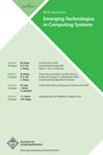
ACM Journal on Emerging Technologies in Computing Systems
Catalyzing Innovation in Electrical and Electronic EngineeringACM Journal on Emerging Technologies in Computing Systems, published by the Association for Computing Machinery, stands as a premier platform dedicated to the exploration and discussion of avant-garde advancements in computing systems. With an ISSN of 1550-4832 and an E-ISSN of 1550-4840, this journal has achieved notable recognition, holding a 2023 Q2 ranking in key fields such as Electrical and Electronic Engineering, Hardware and Architecture, Nanoscience and Nanotechnology, and Software. Spanning from 2005 to 2024, it provides a critical forum for researchers, professionals, and students alike to disseminate innovative research and applications that shape the future of technology. Although currently not open access, the journal's commitment to high-quality, peer-reviewed content ensures its relevance and impact, as reflected in its competitive Scopus ranks across various disciplines. Engage with groundbreaking research that propels the frontiers of computational systems in this dynamic academic journal.
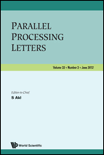
Parallel Processing Letters
Unlocking Innovations in Computational Technologies.Parallel Processing Letters is a notable academic journal published by World Scientific Publishing Co Pte Ltd, focusing on the dynamic fields of Computer Science, particularly in Hardware and Architecture, Software, and Theoretical Computer Science. Established in 1994, this journal provides a platform for the dissemination of cutting-edge research and developments in parallel processing and computational technologies. Despite its current Q4 ranking in multiple categories, Parallel Processing Letters plays an important role in fostering scholarly discussion and innovation within the computing community. With the ISSN 0129-6264 and E-ISSN 1793-642X, the journal is dedicated to maintaining rigorous academic standards while encouraging collaborative research conducive to the advancement of parallel processing systems. It serves as a valuable resource for researchers, professionals, and students seeking to deepen their understanding and gain insights into this rapidly evolving domain.
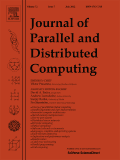
JOURNAL OF PARALLEL AND DISTRIBUTED COMPUTING
Exploring the Dynamics of Parallel and Distributed SystemsJournal of Parallel and Distributed Computing, published by Academic Press Inc. Elsevier Science, is a premier international journal that has been advancing the field of computer science since its inception in 1984. Renowned for its rigorous peer-review process and high-impact research, it holds an impressive impact factor and is categorized in the top quartiles (Q1 and Q2) across multiple domains, including Computer Networks and Communications, Hardware and Architecture, Software, Theoretical Computer Science, and Artificial Intelligence. The journal is dedicated to publishing cutting-edge research that explores the latest developments in parallel and distributed computing, fostering innovation and collaboration among researchers, professionals, and students alike. With a comprehensive scope that spans theoretical foundations, practical applications, and advanced technologies, it serves as an essential resource for anyone invested in these dynamic fields. As a testament to its influence, the journal ranks in the top tiers of Scopus citations, solidifying its reputation as a thought leader in computing research.
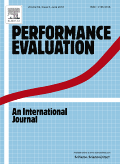
PERFORMANCE EVALUATION
Exploring Innovations in Evaluation MethodologiesPERFORMANCE EVALUATION, published by ELSEVIER, is a prestigious journal that serves as a critical resource for researchers and professionals in the fields of Computer Networks and Communications, Hardware and Architecture, Modeling and Simulation, and Software. With its ISSN 0166-5316 and E-ISSN 1872-745X, this journal is recognized for its contribution to the advancement of performance assessment methodologies and empirical research. Holding a Q3 quartile ranking across multiple categories in 2023, PERFORMANCE EVALUATION is positioned as a valuable platform for disseminating high-quality studies that explore complex performance issues and innovative solutions. Operating from its base in the Netherlands, this journal emphasizes rigorous peer-review standards and enhances its relevance within the academic community by addressing crucial challenges and trends in technology. Stakeholders can access the wealth of knowledge published from 1981 through 2024 by exploring this journal, making it an essential tool for practitioners and scholars aiming to stay at the forefront of computer science research.

DISTRIBUTED COMPUTING
Advancing the Frontiers of Distributed SystemsDISTRIBUTED COMPUTING is a prestigious journal published by SPRINGER that has been a significant contributor to the fields of computational theory, computer networks, and hardware architecture since its inception in 1986. With its ISSN 0178-2770 and E-ISSN 1432-0452, this scholarly publication stands out for its rigorous peer-review process and its commitment to advancing knowledge in distributed systems. The journal has consistently ranked in the Q1 category for multiple relevant domains, reflecting its high impact within the academic community. Although not an open-access journal, DISTRIBUTED COMPUTING offers essential insights and research contributions that are invaluable to researchers, professionals, and students alike. Its scope encompasses various aspects of computational theory and mathematics, ensuring a comprehensive approach to the complexities of distributed systems. With an address in New York, USA, and a delivery timeline extending to 2024, this journal is poised to continue influencing the landscape of computer science and beyond.

Cluster Computing-The Journal of Networks Software Tools and Applications
Navigating the Future of Cluster Computing TogetherCluster Computing - The Journal of Networks Software Tools and Applications, published by Springer, is a premier academic journal catering to the vibrant fields of computer networks and software technologies. With an impressive impact factor and recognized as a Q1 journal in both Computer Networks and Communications and Software categories for 2023, it ranks within the top echelons of its field, boasting a Scopus rank of #50 out of 395 and #59 out of 407 respectively, highlighting its influence and reach. The journal, which has been in continuous publication since 2005, serves as a vital platform for groundbreaking research, offering insightful articles and tools that drive innovation in network computing. Researchers, professionals, and students are invited to contribute to and benefit from the dynamic discourse presented in this journal, which is pivotal for advancing knowledge and enhancing practical applications in a rapidly evolving technological landscape.
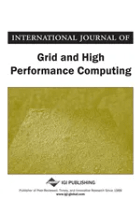
International Journal of Grid and High Performance Computing
Fostering Breakthroughs in Grid and High-Performance TechnologiesThe International Journal of Grid and High Performance Computing, published by IGI Global, is a vital resource in the fields of grid and high-performance computing. With an ISSN of 1938-0259 and an E-ISSN of 1938-0267, this journal has been dedicated to advancing knowledge and innovation since its inception in 2009, and is set to continue publishing groundbreaking research until 2024. Despite its current Q4 categorization in the Computer Networks and Communications field, the journal plays a crucial role in fostering interdisciplinary collaboration and sharing pioneering work that addresses the growing demands of computational performance and network efficiency. Although it does not offer open access, subscribers gain invaluable insights into contemporary issues and developments within this rapidly evolving discipline. The journal aims to attract original research articles, reviews, and case studies, making it an essential platform for researchers, professionals, and students keen on exploring the complexities of grid computing and its applications.
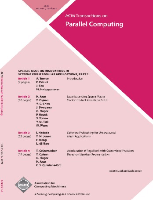
ACM Transactions on Parallel Computing
Elevating Research in Distributed ArchitecturesACM Transactions on Parallel Computing (ISSN: 2329-4949; E-ISSN: 2329-4957), published by the Association for Computing Machinery, stands as a pivotal journal in the field of computer science, particularly focusing on the advancements in parallel and distributed computing. With its convergence years spanning from 2014 to 2024, this journal serves as a significant platform for disseminating cutting-edge research, methodologies, and technologies that shape the future of computational theory, hardware architectures, and effective software solutions. Although it currently holds a Q3 category ranking in various subfields including Computational Theory and Mathematics, and Modeling and Simulation, it continues to attract researchers aiming to contribute to its growing impact in the field. The journal's commitment to fostering knowledge exchange makes it an essential resource for professionals and students eager to navigate the complexities of parallel computing. As the field evolves, ACM Transactions on Parallel Computing remains a critical reference point for innovative research and professional development in computer science.